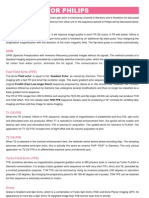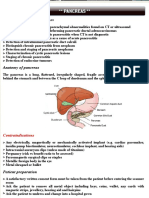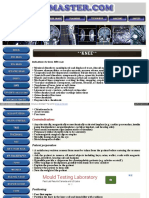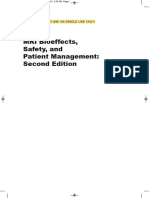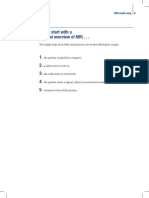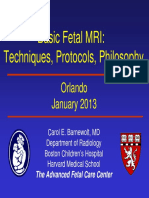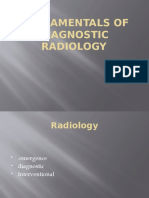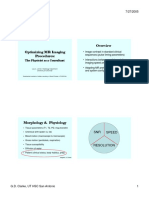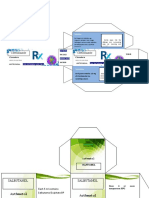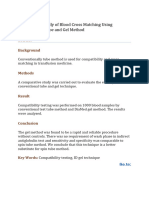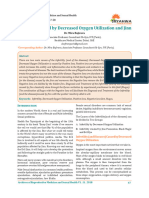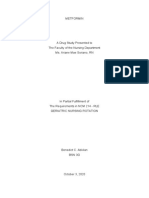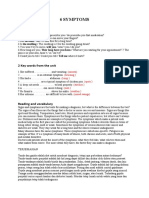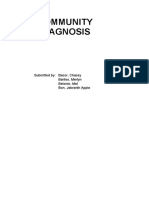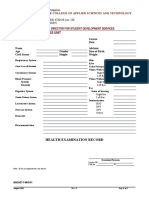MRI Sequences and Protocols
Uploaded by
07lordkingMRI Sequences and Protocols
Uploaded by
07lordkingDedicated to
Dr. Samiran Samanta
MRI Sequences and Protocols: PB 2
Prasenjit Banerjee
Diploma in Radiodiagnostics (DRD) from
IPGME&R, Kolkata
B.SC(General) from Asutosh College,
Calcutta University
Presently working at SSKM Hospital,
Kolkata
prasenjitbanerjee.27@gmail.com
“I have written this book with the experience I have
accumulated in my 12 years of MRI career. Hope all the
learners will find this book useful to learn their MRI
education.”
First edition: January 2025
MRI Sequences and Protocols: PB 3
Content
T1 weighted FSE sequence 09
T2 weighted FRFSE sequence 12
T2 weighted SSFSE sequence 15
PD weighted FSE sequence 17
Propeller or BLADE sequence 19
FLAIR sequence 21
STIR sequence 23
FAT Suppression sequence 25
DWI- EPI sequence 27
DTI Sequence 29
PWI- EPI sequence 31
T2* weighted GRE sequence 33
MERGE or MEDIC sequence 35
SWI Sequence 37
BRAVO sequence 39
FIESTA or CISS sequence 41
COSMIC sequence 43
SPGR or FLASH sequence 45
MRI Sequences and Protocols: PB 4
MPRAGE or IR-SPGR sequence 47
LAVA Flex or VIBE sequence 49
MENSA or DESS sequence 51
3D TOF MRA sequence 53
MRV sequence 55
PC-MRA sequence 57
TRICKS or TWIST sequence 59
DISCO sequence 61
IFIR sequence 63
MT sequence 65
Spectroscopy sequence 67
Marvic SL sequence 69
MDE sequence 71
Acronyms 73
Brain Basic Protocol 77
Brain Tumour Protocol 78
Brain Stroke Protocol 79
Brain Epilepsy Protocol 80
Brain Dementia Protocol 81
Brain Imflammation Protocol 82
MRI Sequences and Protocols: PB 5
Pituitary Protocol 83
Orbit Protocol 84
Cranial Nerve Protocol 85
Face and Neck Protocol 86
Brachial Plexus Protocol 87
Neck Angio Protocol 88
Spine Basic Protocol 89
Spine Contrast Protocol 90
Sacroiliac Joint Protocol 91
MRCP Protocol 92
Liver Protocol 93
MRU Protocol 94
Adrenal and Kidney Protocol 95
Breast Protocol 96
Cardiac Protocol 97
Aortic Angio Protocol 98
Pelvis Protocol 99
Rectum Protocol 100
Prostate Protocol 101
Fistulogram Protocol 102
Shoulder Joint Protocol 103
MRI Sequences and Protocols: PB 6
Elbow Joint Protocol 104
Wrist Joint Protocol 105
Humerus or Forearm Protocol 106
Hip Joint Protocol 107
Thigh or leg Protocol 108
Knee Joint Protocol 109
Ankle Joint Protocol 110
Foot Protocol 111
References 112
MRI Sequences and Protocols: PB 7
MRI
Sequences
MRI Sequences and Protocols: PB 8
T1 Weighted FSE
Sequence
• T1 weighted Fast Spin Echo sequence
• T1 weighted images are useful for demonstrating
anatomy because they have a high SNR..
• Conventional or fast spine echo produces T1 weighted
images of good quality and may be used in any part of
the body, for any indication.
• In this images fluids are very dark, water based tissues
are gray and fat based tissues are very bright.
• T1-weighted images are produced by using short TE
and short TR times.
• T1-weighted sequences provide the best contrast
for paramagnetic contrast agents (e.g. gadolinium-
containing compounds).
MRI Sequences and Protocols: PB 9
Signal intensities seen in T1 weighted images.
High signal fat
blood
haemangioma
intraosseous lipoma
radiation change
degeneration fatty deposition
methaemoglobin
cysts with proteinaceous fluid
paramagnetic contrast agents
slow‐flowing blood
Low signal cortical bone
avascular necrosis
infarction
infection
tumours
sclerosis
cysts
calcification
No signal air
fast‐flowing blood
tendons
cortical bone
scar tissue
MRI Sequences and Protocols: PB 10
MRI Sequences and Protocols: PB 11
T2 Weighted FRFSE
Sequence
• T2 weighted Fast Recovery Fast Spin Echo sequence.
• In this images fluids are very bright, water and fat
based tissues are mid grey.
• T2 weighted images demonstrate pathology. Tissues
that are diseased are generally more edematous and/or
vascular. They have increased water content and
consequently have a high signal on T2 weighted images
and can therefore be easily identified.
• This sequence produces an increase in signal intensity
in fluid - based structures such as cerebrospinal fluid
(CSF) when using shorter TRs than normal in FSE.
• T2-weighted images are produced by using long TE
and long TR times.
MRI Sequences and Protocols: PB 12
Signal intensities seen in T2 weighted images.
High signal water
synovial fluid
haemangioma
infection
inflammation
oedema
some tumours
haemorrhage
slow‐flowing blood
cysts
Low signal cortical bone
bone islands
deoxyhaemoglobin
haemosiderin
calcification
T2 paramagnetic agents
No signal air
fast‐flowing blood
tendons
cortical bone
scar tissue
calcification
MRI Sequences and Protocols: PB 13
MRI Sequences and Protocols: PB 14
T2 Weighted SSFSE
Sequence
• It is possible to acquire fast spin echo images in even
shorter scan times by using a technique known as
single shot fast spin echo (SSFSE).
• SSFSE is particularly effective when applied to
MRCP, MRU and MRE. Less well established roles
include gastrointestinal imaging in which the
patient's intrinsic fluid acts as contrast medium.
• It can be acquired in second as a breath hold
sequence or with respiratory triggering.
• It is used for image of heart and bowel imaging.
• These sequence is useful for joints and bones study.
MRI Sequences and Protocols: PB 15
MRI Sequences and Protocols: PB 16
PD Weighted FSE
Sequence
• Proton density weighted fast spine echo sequence.
• The proton density of a tissue is the number of
mobile hydrogen protons per unit volume of that
tissue. The higher the proton density of a tissue, the
more signal available from that tissue.
• To achieve PD image, both T1 and T2 effects are
diminished. Selecting a long TR reduces T1 effects
and T2 effects are diminished by selecting a short TE.
• Proton density contrast is always present and
depends on the patient and the area being examined.
• Proton density weighted images show anatomy and
some pathology.
MRI Sequences and Protocols: PB 17
MRI Sequences and Protocols: PB 18
Propeller or BLADE
Sequence
• Propeller- Periodically rotated overlapping parallel
lines with enhance reconstruction.
• BLADE- Balanced steady state free precession line
acquisition with undersampling.
• “BLADE” and “PROPELLER” are terms used to
describe advanced imaging techniques that aim to
reduce motion artifacts in images caused by patient
movement during the scan.
• These techniques are particularly useful in situations
where patients have difficulty remaining still, such
as pediatric or critically ill patients.
• The basic idea was to sample k-space in a rotating
fashion using a set of radially directed strips or
"blades".
MRI Sequences and Protocols: PB 19
Without PROPELLER:
Patient motion artifacts
on routine FSE image
With PROPELLER:
Motion artifacts
substantially reduced
MRI Sequences and Protocols: PB 20
FLAIR Sequence
• FLAIR- Fluid attenuated inversion recovery
sequence.
• This is a long TI (1500-2500 ms) inversion recovery
sequence used for T2-w imaging with suppression of
fluid.
• It is mainly used in neuroimaging where CSF is
effectively suppressed and heavily T2- weighted
images can be obtained without problems from CSF
partial volume effects and artifacts.
• It can also be acquired after contrast injection.
• Extent of perilesional edema can be determined
easily.
• Brain infarctions are well seen on FLAIR.
• Bright lesions of multiple sclerosis are better seen on
FLAIR.
• Increased signal in mesial temporal sclerosis is better
appreciated on FLAIR.
• Fast FLAIR shows subarachnoid haemorrhage.
• Syrinx/cysts in spinal cord are well seen on FLAIR.
MRI Sequences and Protocols: PB 21
MRI Sequences and Protocols: PB 22
STIR Sequence
• STIR- Short tau inversion recovery.
• This is a short TI (100-180 ms) inversion recovery
sequence used for T2-w imaging with suppression of
fat.
• Fat suppression on STIR images is more robust and
homogenous as compared to T2-weighted fat
saturated images but STIR has lower SNR than T2-w
FSE sequence.
• STIR is used all most everywhere in the body imaging.
• STIR shows marrow edema very well. It is very useful
detecting multiple lesions in bones and is used for
bone metastases screening in whole-body MRI.
• It is used in orbital imaging especially for optic nerves.
• It is used in SI joint imaging and shows marrow
edema earlier than erosions seen on CT scan in
arthropathies.
MRI Sequences and Protocols: PB 23
MRI Sequences and Protocols: PB 24
FAT Suppression
Sequences
• Fat suppression, i.e. nulling signal from the fat tissues,
is used to differentiate other short T1 tissues (e.g.
enhancing lesion) from fat in any lesion or structure.
• Fat suppression is used to detect presence of fat in any
lesion or organ.
• It is used to improve the visibility of bone marrow
lesions, soft tissue masses, and contrast material
uptake..
• To reduce chemical shift artifacts and improve image
quality.
• There are 5 basic techniques of fat suppression
including
1. Frequency selective fat suppression
2. STIR
3. Out-phase imaging
4. Dixon method
5. Selective water excitation
MRI Sequences and Protocols: PB 25
MRI Sequences and Protocols: PB 26
DWI-EPI Sequence
• Diffusion weighted Echo planner imaging sequence.
• Diffusion is a term used to describe moving molecules
due to random thermal motion. It is also called
Brownian motion.
• This motion is restricted by boundaries such as
ligaments, membranes and macromolecules and by
pathology.
• DWI is commonly used in the diagnosis of stroke
where areas of decreased diffusion, which represent
infarction, are bright.
• In early stroke, cells swell and absorb water from the
extracellular space and diffusion is restricted.
• DWI is also useful in other areas such as the liver,
prostate and breast to differentiate between
malignant and benign lesions and to differentiate
solid from cystic areas.
MRI Sequences and Protocols: PB 27
MRI Sequences and Protocols: PB 28
DTI Sequence
• Diffusion tensor imaging.
• Routine diffusion weighted imaging is based on the
isotropic diffusion. DTI is based on the anisotropic
diffusion of water molecules. Tensor is the
mathematical formalism used to model anisotropic
diffusion.
• Diffusion tensor image shows white matter tracts very
well. Hence this technique also called as tractography.
• Various maps used to indicate orientation of fiber
tracts include FA (fractional anisotropy), RA (regional
anisotropy) and VA (volume ratio) maps.
• Tractography is useful for the assessment of
relationship of tracts with tumor, tumor invasion of
tracts and preoperative planning.
• It is also used to evaluate white matter tracts in
various congenital anomalies and dysplasias.
MRI Sequences and Protocols: PB 29
MRI Sequences and Protocols: PB 30
PWI-EPI Sequence
• Perfusion weighted Echo planner imaging.
• Perfusion refers to the passage of blood from an
arterial supply to venous drainage through the
microcirculation.
• Perfusion is necessary for the nutritive supply to the
tissues and for the clearance of products of
metabolism.
• Perfusion can be affected by various disease processes
affecting the particular tissue.
• Perfusion imaging involves rapidly T2* weighted EPI
imaging before, during and after injection of
gadolinium to measure the perfusion kinetics of
tissue.
• From the raw data images various color coded maps
are constructed using software.
• Perfusion imaging is commonly used in evaluation of
ischaemic disease or metabolism. On the CBV map,
areas of low perfusion (e.g. stroke) appear dark,
whereas areas of higher perfusion (e.g. malignancy)
appear bright.
MRI Sequences and Protocols: PB 31
MRI Sequences and Protocols: PB 32
T2* Weighted GRE
Sequence
• T2* weighted 2D Gradient recalled echo sequence.
• GRE sequences are used when fast imaging is
important because of their short repetition times.
• As blood iron concentration can effect the local
magnetic field, a GRE sequence is a able to
indicate iron deposit and micro hemorrhage.
• These sequences are used to detect hemorrhage,
hemosiderin deposition and calcification.
• GRE T2*WI sequences are used to study degenerative
diseases, microdamage, and tumors.
MRI Sequences and Protocols: PB 33
MRI Sequences and Protocols: PB 34
MERGE or MEDIC
Sequence
• Multiple Echo Recombined Gradient Echo (MERGE)
is a technique that uses multiple echoes to create
high-resolution images of the c-spine to visualise of
spinal cord structures, intervertebral discs, and
surrounding tissues.
• The corresponding Siemens sequence is called MEDIC
("Multi-Echo Data Image Combination"), while the
Philips sequence is called M-FFE ("Merged Fast Field
Echo").
• 3D MERGE also offers excellent SNR and fat-
saturation capabilities to provide high resolution,
isotropic T2* weighted images of the extremities
(hand, wrist, knee, ankle, and shoulder) with
optimized contrast between the ligaments and soft
tissue.
• The high resolution and contrast make MEDIC
particularly useful for visualizing hyaline cartilage,
crucial for diagnosing osteoarthritis and other
cartilage-related pathologies.
MRI Sequences and Protocols: PB 35
MRI Sequences and Protocols: PB 36
SWI Sequence
• Susceptibility weighted imaging sequence.
• SWI provides a clear depiction of venous
vasculature, particularly small veins that might not
be well-visualized using other MRI techniques.
• Brain microbleeds, which are small chronic brain
hemorrhages, are better visualized with SWI.
• SWI can help detect shearing injuries,
microhemorrhages, and other vascular injuries in
patients with traumatic brain injury.
• In cases of stroke, SWI can provide valuable
information about the presence and extent of
hemorrhage or the pattern of venous drainage.
• SWI can help in characterizing certain tumors
based on the presence of hemorrhage, calcification,
or vascular patterns.
• SWI can highlight the abnormal blood vessels and
associated hemorrhages in AVMs.
MRI Sequences and Protocols: PB 37
MRI Sequences and Protocols: PB 38
BRAVO Sequence
• A BRAVO sequence is a T1 weighted 3D Gradient-Echo
(GRE) sequence to create a brain volume image.
• BRAVO sequences can be reconstructed through
multiple planes, allowing for the tracking of small
blood vessels to identify lesions and strengthened
vessels.
• It can be used to evaluate the location, morphology,
and anatomical relationship of lesions.
• Observe the relationship between blood vessels and
nerves.
• The 3D-BRAVO enhanced sequence significantly
improved the detection rate of cranial nerve lesions,
compared with conventional 2D enhanced.
MRI Sequences and Protocols: PB 39
MRI Sequences and Protocols: PB 40
FIESTA or CISS
Sequence
• FIESTA- Fast imaging employing steady state
acquisition.
• CISS- Constructive interference at steady state.
• It is a 3D T2* weighted Balance gradient echo
sequence.
• This 3D sequence can provide thin slice high
resolution images of posterior cranial fossa showing
cranial nerves dark against the background of bright
CSF.
• CISS is routinely performed for suspected internal
auditory canal and cerebello-pontine angle cistern
pathology.
• CISS can also be used to visualize spinal nerve roots
and optic nerve.
• However, it is also used in the abdominal system to
reduce flow artifacts in the biliary and circulatory
systems .
• Although this sequence was primarily developed for
use in cardiac imaging.
MRI Sequences and Protocols: PB 41
MRI Sequences and Protocols: PB 42
COSMIC Sequence
• The COSMIC (Coherent Oscillatory State acquisition
for the Manipulation of Image Contrast) sequence
is a variant of the FIESTA-C sequence used in MRI.
• It's used to detect nerve root lesions that are adjacent
to soft tissue.
• COSMIC has a higher signal-to-noise ratio and
contrast-to-noise ratio than 3D FIESTA and 2D
sequences. This allows for multi-planar
reconstruction without much image degradation.
• It used to diagnose of nerve root compression and
spinal canal stenosis.
MRI Sequences and Protocols: PB 43
MRI Sequences and Protocols: PB 44
SPGR or FLASH
Sequence
• SPGR- Spoiled gradient recalled echo. It is a T1
weighted GRE sequence.
• FLASH- Fast low angle shot MRI.
• These sequences can be acquired with echo times
when water and fat protons are in-phase and out-of-
phase with each other. This ‘in- and out-of-phase
imaging’ is used to detect fat in the lesion or organs.
• Spoiled GRE sequences are modified to have time-of-
flight MR Angiographic sequences.
• The 3D versions of these sequences can be used for
dynamic multiphase post contrast T1-weighted
imaging.
• SPGR produces high quality images with improved
spatial resolution.
• Examples include 3D FLASH and VIBE (Siemens),
LAVA and FAME (GE), and THRIVE (Philips).
MRI Sequences and Protocols: PB 45
MRI Sequences and Protocols: PB 46
MPRAGE or IR-SPGR
Sequence
• Magnetization-Prepared Rapid Gradient Echo (MP-
RAGE) is a 3D MRI sequence that produces high-
resolution T1-weighted images of the brain.
• It begins with a 180-degree inversion pulse with
medium TI , followed by a GRE imaging sequence in
a steady state that employs rewinder gradients.
• Because of their good gray-white differentiation
ability they are used in the epilepsy protocol for the
evaluation of mesial temporal sclerosis and
detection of cortical dysplasia.
• MP-RAGE sequences are used for high-resolution 3D
isotropic brain imaging, volumetric analysis, and
pre-surgical planning.
MRI Sequences and Protocols: PB 47
MRI Sequences and Protocols: PB 48
LAVA Flex or VIBE
Sequence
• LAVA-Flex (Liver Volume Accelerated Flex
Acquisition) is a 3D MRI imaging technique that
generates water-only, fat-only, in-phase, and out-of-
phase images in a single acquisition.
• VIBE- volumetric interpolated breath-hold
examination.
• It's a T1-weighted spoiled 3D Gradient Recalled Echo
(GRE) pulse sequence that can be acquired as a free
breathing dynamic scan or with a patient breath-
hold.
• Provides uniform fat suppression across the entire
field of view, including areas that are difficult to
image with conventional fat suppression.
• LAVA-Flex provides excellent visualization of nerves
and vessels.
• This sequences can be completed faster than other
sequences and allows for image reconstruction in any
desired plane.
MRI Sequences and Protocols: PB 49
MRI Sequences and Protocols: PB 50
MENSA or DESS
Sequence
• MENSA- Multi-Echo in Steady-state Acquisition.
• DESS- Double Echo Steady State.
• DESS has both T1 and T2 contrast hence anatomy as
well as fluid is seen very well.
• It is a specialized MRI sequence primarily employed in
musculoskeletal imaging, providing high-resolution
images of cartilage.
• It proves particularly valuable in assessing
morphology of articular cartilage, detecting cartilage
lesions and synovial fluid very well.
• MENSA can provide contrast between nerve roots,
ligamentum flavum, bone, intervertebral discs and
help understand disc herniation and compression of
adjacent tissues.
MRI Sequences and Protocols: PB 51
MRI Sequences and Protocols: PB 52
3D TOF MRA
Sequence
• A time-of-flight (TOF) sequence in an MRI is a non-
contrast enhancement technique that visualizes blood
flow in vessels.
• The base-sequence used for TOF-MRA is spoiled GRE
sequence with gradient moment rephasing.
• TOF is a safer and more convenient technique for
patients because it doesn't require contrast. It can
visualize both arterial and venous vessels with high
spatial resolution.
• TOF doesn't provide information about flow velocity
or directionality. Materials with short T1 relaxation
times may contaminate the TOF images.
• Very useful for circle of willis and carotid arteries
imaging.
MRI Sequences and Protocols: PB 53
MRI Sequences and Protocols: PB 54
MRV Sequence
• Magnetic resonance venography (MRV) is a non-
invasive imaging technique that uses MRI
technology to create detailed images of veins and
blood flow.
• It's often used to diagnose and stage venous
disorders, such as blood clots, venous
malformations, and venous stenosis.
• MRV can be used to examine the brain, neck, chest,
and other parts of the body.
• MRV can help diagnose conditions such as dural
sinus thrombosis, central venous obstruction,
axillary-subclavian venous obstruction,
thrombophlebitis.
MRI Sequences and Protocols: PB 55
MRI Sequences and Protocols: PB 56
PC-MRA Sequence
• A phase contrast (PC) magnetic resonance
angiography (MRA) sequence uses bipolar gradients
to generate images and measure blood flow velocity
and pressure gradients.
• PC-MRA uses change in the phase of transverse
magnetization of the flowing blood to produce image
of the flowing blood.
• Accurate velocity estimation depends on avoiding
phase aliasing and detecting slow flow in
vessels. Users must also carefully select an
appropriate value for the velocity encoding (VENC)
parameter.
• A high VENC is used for arteries (40-70 cm/sec) due
to the rapid arterial flow, while a low VENC is utilized
for veins (10-20 cm/sec) owing to the slower venous
flow.
• It is very useful for dural venous sinus imaging, circle
of willis and carotid arteries imaging.
MRI Sequences and Protocols: PB 57
MRI Sequences and Protocols: PB 58
TRICKS or TWIST
Sequence
• TRICKS- Time-Resolved Imaging of Contrast
Kinetics.
• TWIST- Time-resolved angiography with interleaved
stochastic trajectories.
• The sequence used for contrast enhanced MRA is
usually a modified T1-weighted spoiled gradient
refocused GRE sequence.
• TRICKS rapidly generates time resolved 3D images of
blood vessels to meet the challenge of capturing peak
arterial phases with minimal venous contamination.
• With TRICKS, the different vascular phases can be
extracted, quickly and easily, after image acquisition.
• Time-resolved MRA sequences are widely used
wherever circulation is rapid (carotids, cardio-
pulmonary system) or unpredictable (extremities).
• The method is particularly useful for evaluating
collateral or retrograde flow around stenoses and in
the work up of arteriovenous malformations.
MRI Sequences and Protocols: PB 59
MRI Sequences and Protocols: PB 60
DISCO Sequence
• DISCO- DIfferential Subsampling with Cartesian
Ordering.
• It is used for dynamic contrast-enhanced imaging of
the breast, liver, and prostate.
• It's a variable-spatio-temporal-resolution imaging
sequence that can capture the dynamics of tumors
and structural features after contrast.
• DISCO is incorporated into a 3D spoiled-GRE core
sequence with dual in phase-out of phase echoes
allowing separation of fat and water signals.
• Although used for dynamic perfusion imaging instead
of for MRA, GE's sequence DISCO shares similar
features with TRICKS and TWIST.
MRI Sequences and Protocols: PB 61
MRI Sequences and Protocols: PB 62
IFIR Sequence
• IFIR- Inhance Inflow Inversion Recovery (GE).
Synonyms are Native True FISP(Siemens), B-Trance
(Philips), VASC-ASL(Hitachi), Time SLIP(Canon).
• It uses a preparatory inversion pulse to reduce the
signal from static tissue while leaving inflow arterial
blood unaffected.
• The relative high signal of arterial blood on balanced
steady state free precession sequences.
• This technique is used in non contrast magnetic
resonance angiography (MRA) to evaluate abdominal
and peripheral arteries.
• Like many noncontrast abdominal MRA techniques,
IR-prepped balanced SSFP works well in relatively
healthy patients with normal vascular flows who can
hold still and maintain a regular respiratory pattern,
but produces suboptimal images in sick or
uncooperative patients.
MRI Sequences and Protocols: PB 63
MRI Sequences and Protocols: PB 64
MT Sequence
• Magnetization transfer (MT) is an MRI technique
that improves image contrast by selectively saturating
the signal from immobile water protons.
• It can be used to differentiate between lesions, detect
disease load, and help predict the cause of
meningitis.
• MT suppresses background tissue signals while
affecting negligibly to enhancing lesion or structure.
Thus improves visualization of the lesion.
• MT suppresses background tissue while preserves
signal from blood vessels resulting into improved
small vessel visualization.
• Apart from increasing conspicuity of enhancing
lesion MT is also being studied to characterize lesions
into benign and malignant depending on their
macromolecular environment and high molecular
weight nuclear proteins.
MRI Sequences and Protocols: PB 65
MRI Sequences and Protocols: PB 66
Spectroscopy
Sequence
• Magnetic resonance spectroscopy (MRS) is a
noninvasively assess various metabolites or
biochemicals from the body tissues.
• This metabolite information is then used to diagnose
diseases, monitoring diseases and assessing response
to the treatment.
• Chemical shift imaging is the basis of MRS.
• In present clinical practice, four methods are
commonly used for the localization of volume of
interest. They are STEAM, PRESS, ISIS and CSI.
• STEAM, PRESS and ISIS are used for single voxel
spectroscopy (SVS). CSI is a multivoxel (MVS)
technique.
• MRS can help differentiate between high grade and
low grade brain tumors.
• MRS can help diagnose disorders like Canavan's
disease, creatine deficiency, and untreated bacterial
brain abscess.
MRI Sequences and Protocols: PB 67
MRI Sequences and Protocols: PB 68
MARVIC SL
Sequence
• Multi-Acquisition with Variable Resonance Image
Combination SeLective.
• It's a hybrid technique used in magnetic resonance
imaging (MRI) to reduce metal artifacts around small
implants.
• The MAVRIC SL MRI sequence is a technique that uses
a combination of 3D Fast Spin Echo (FSE) sequences.
• MAVRIC SL can improve the visualization of bone and
soft tissue, and produce diagnostic quality images. It
can be particularly useful for patients with hip
arthroplasty, where metal artifacts can compromise
imaging.
• It should only be used with MR Conditional implants
and within the MR conditions specified for those
implants.
MRI Sequences and Protocols: PB 69
MRI Sequences and Protocols: PB 70
MDE Sequence
• The myocardial delayed enhancement (MDE) MRI
sequence is a segmented inversion recovery gradient
recalled echo (IR-GRE) sequence that uses breath-
holds to acquire images.
• The sequence is used to diagnose myocardial
involvement in various cardiac and non-cardiac
disorders.
• A gadolinium-based contrast agent is injected
intravenously 10–20 minutes before the scan.
• The time between the inversion recovery pulse and
image acquisition is called the inversion time
(TI). The TI needs to be optimized for each case.
• With optimal settings, normal myocardium appears
black and myocardial scar areas appear bright.
• MDE MRI is used to evaluate the myocardium at risk,
determine treatment options, and assess the presence
of a scar.
• The patterns of delayed hyper-enhancement can help
identify the type of pathology. For example, ischemic
heart disease is often associated with subendocardial
and transmural enhancement patterns.
MRI Sequences and Protocols: PB 71
MRI Sequences and Protocols: PB 72
Acronyms
MRI Sequences and Protocols: PB 73
MRI Sequences and Protocols: PB 74
MRI Sequences and Protocols: PB 75
MRI
Protocols
MRI Sequences and Protocols: PB 76
Brain Basic
Protocol
Indication
Headache, Altermental Status,Psycreatric Disorder,
Generalised non-specific symptoms, Arachnoid cyst,
Epidermoid
• AX DWI
• AX T2
• AX T2 FLAIR FS
• AX T1 FLAIR FS
• AX GRE
• COR T2
• SAG T2
MRI Sequences and Protocols: PB 77
Brain Tumour
Protocol
Indication
Space occupying lesion (SOL) or tumour, e.g.
meningioma, astrocytoma, glioblastoma multiforme
(GBM), metastases
• Brain Basic Protocol
• AX Perfusion Dynamic
• AX BRAVO+C
• AX T1 FS+C
• COR T1 FS+C
• SAG T1 FS+C
• SPECTROSCOPY
MRI Sequences and Protocols: PB 78
Brain Stroke
Protocol
Indication
Cerebro vascular attack (CVA), Hemorrhage, Trauma,
Transient Ischemic Attack (TIA), Vertibro basilar infarct,
Avascular Malformations, Aneurysm
• Brain basic protocol
• AX 3D SWAN
• 3D TOF MRA
• VENOGRAM (h/o Venous sinus thrombosis)
• AX PERFUSION (Dynamic )
MRI Sequences and Protocols: PB 79
Brain Epilepsy
Protocol
Indication
Epilepsy, Mesial temporal sclerosis, Seizure, Delay
Development, Hypoxic-Ischemic Encephalopathy (HIE) ,
Dysplasia, EEG abnormality, Abnormal grey matter
migration , Assessment of hippocampal volume
• Brain basic protocol
• SAG T1 FLAIR
• COR T2 FLAIR
• 3D OBL SPGR
MRI Sequences and Protocols: PB 80
Brain Dementia
Protocol
Indication
Dementia, Demyelination, e.g. multiple sclerosis (MS)
• SAG 3D T1 MPRAGE / IR – SPGR
• SAG T1 FLAIR
• AXIAL T2 GRE / SWI
• AXIAL T2 FLAIR
• AXIAL DWI
• CORONAL DWI
MRI Sequences and Protocols: PB 81
Brain Inflammation
Protocol
Indication
Encephalitis or meningitis, Acute disseminated
encephalomyelitis (ADEM),
• Brain basic protocol
• AX BRAVO+C
• AX T1 FS+C
• COR T1 FS+C
• SAG T1 FS+C
MRI Sequences and Protocols: PB 82
Pituitary Protocol
Indicaton
Pituitary Dysfunction, Macroadenoma, Microadenoma or
prolactinoma, Supra cellar mass, Delayed onset or
precocious puberty, Galactorrhoea, Menstrual irregularity
or amenorrhoea, Cushing’s disease (ACTH dependent
Cushing’s syndrome), Craniopharyngioma, Diabetes
insipidus, Pituitary apoplexy (due to infarction or
haemorrhage)
• SAG T2 THIN
• SAG T1 FS THIN
• COR T2 THIN
• COR T1 FS THIN
• COR T1 FS THIN+C (DYNAMIC)
• SAG T1 FS THIN+C
• AX T1 FS THIN+C
• COR T1 FS THIN+C (DELAYED)
MRI Sequences and Protocols: PB 83
Orbit Protocol
Indication
Proptosis, Visual disturbance, Occular mass lesson,
Optic disc distortion or pallor, Infection or
inflammation, e.g. orbital cellulitis, Intra-ocular
lesions, Retinoblastoma, Melanoma, Orbital infections
• AX T2
• AX T2 FS THIN
• COR T2 FS THIN
• COR T1 FS THIN
• RT SAG T2 FS THIN
• LT SAG T2 FS THIN
• RT SAG T1 FS THIN
• LT SAG T1 FS THIN
MRI Sequences and Protocols: PB 84
Cranial Nerve
Protocol
Indication
CPA Tumor, Trigaminal Nuralgia, Hearing loss, Post IAC
Surgery, Pre coclear implant, Facial nerve palsy,
Labyrinthitis , 3rd Nerve palsy, Mass, trigeminal
schwannoma/neuroma, Type I neurofibromatosis
• Brain basic protocol
• AX 3D FIESTA
• AX 3D BRAVO+C
• AX T1 FS+C
• COR T1 FS+C
• SAG T1 FS+C
MRI Sequences and Protocols: PB 85
Face and Neck
Protocol
Indication
Carcinoma of the larynx and hypopharynx, Benign
lesions of the larynx, Second or third branchial cleft
cyst, Tumor, Infection, ENT Tumor, Sinus Infection
• SAG T2
• COR T2
• AX T2
• AX T2 FS
• AX T1
• AX T1 FS
• AX DWI
• AX T1 FS+C
• SAG T1 FS+C
• COR T1 FS+C
MRI Sequences and Protocols: PB 86
Brachial Plexus
Protocol
Indication
Trauma, Malignancy, e.g. primary nerve sheath tumour,
Benign tumour, Neurofibromatosis, Radiation fibrosis
• COR 3D T2 FS CUBE
• SAG T2
• SAG T1
• AX T2
• AX T2 FS
MRI Sequences and Protocols: PB 87
Neck Angio
Protocol
Indication
Carotid, vertebral or cervical artery dissection or
stenosis, Horner’s syndrome, Known, suspected or
family history of intracranial aneurysm, Congenital
vascular anomalies, e.g. Moyamoya disease or
arteriovenous malformation (AVM)
• Face and Neck protocol
• AX 3D TOF
• PC-MRA NECK
• TRICKS+C (DYNAMIC)
MRI Sequences and Protocols: PB 88
Spine Basic
Protocol
Indication
Radiculopathy, Low Back Pain, Trauma, Myelopathy,
Herniated disc, Scoliosis, Sciatica, Cauda equina
syndrome, Arthritis (RA or OA), Cord Compression,
Syringomyelia/syrinx
• SAG T2
• SAG T2 FS
• SAG T1
• COR T2
• COR T2 FS
• AX T2
• AX T1
• SAG MERGE
• AX 3D COSMIC
• MYLO
MRI Sequences and Protocols: PB 89
Spine Contrast
Protocol
Indication
Disc lesion, Primary malignancy, e.g. ependymoma,
Secondary malignancy, e.g. germinoma, Benign tumour,
e.g. meningioma, Demyelination, e.g. MS, Transverse
Myelitis, Neuro Fibromatosis
• Spine basic protocol
• SAG T1 FS
• SAG T1 FS+C
• COR T1 FS+C.
• AX T1 FS+C
MRI Sequences and Protocols: PB 90
Sacroiliac Joint
Protocol
Indication
Sacroiliitis , Low back pain, Arthritis (RA or OA),
Malignancy, most frequently metastatic bone lesions,
Insufficiency fracture
• SAG T2
• OBL/ COR T2
• OBL/ COR T2 FS/STIR
• OBL/ COR T1
• AX T2
• AX T2 FS
MRI Sequences and Protocols: PB 91
MRCP Protocol
Indication
Obstructive Jaundice, Intra Hepatic Billiary Duct Post
Operative condition, Pancreatic Duct Abnormalities,
Biliary obstruction, including choledocholithiasis,
Primary or secondary sclerosing cholangitis, Pancreas
divisum
• AX T2 BH / RTr
• COR T2 BH/ RTr
• 3D MRCP RTr
• THICK SLAB BH
• AX LAVA FLEX
MRI Sequences and Protocols: PB 92
Liver Protocol
Indication
SOL, Characterisation of lesions, Primary versus
metastatic – Malignant versus benign, Follicular
nodular hyperplasia (FNH), Hepatocellular carcinoma
(HCC), Haemangioma, Hydatid cyst , Diffuse liver
disease, e.g. haemochromatosis, cirrhosis,
Cholangiocarcinoma.
• AX T2 BH/ RTr
• AX T2 FS BH/ RTr
• AX T1 BH
• AX T1 FS BH
• AX DWI RTr
• AX DUAL ECHO BH
• COR T2 BH/ RTr
• COR T2 FS BH/ RTr
• AX LAVA FLEX BH
• AX LAVA FLEX+C BH (TRI-PHASIC DYNAMIC)
• COR LAVA FLEX+C BH
• AX LAVA FLEX+C BH (DELAYED)
MRI Sequences and Protocols: PB 93
MRU Protocol
Indication
For the evaluation of urinary tract in patients with
renal failure, For the evaluation of non-excreting
kidneys in IVU, Urinary obstruction
• AX FIESTA BH
• COR FIESTA BH
• 3D MRU Rtr
MRI Sequences and Protocols: PB 94
Adrenals and Kidney
Protocol
Indication
Pheochromocytoma (PCC), Raised ACTH levels,
Cushing’s syndrome (non-ACTH dependent; due to a
non-pituitary cause), Adrenal adenoma or
adrenocortical carcinoma (ACC), Renal cell cancer
(RCC), Metastases
• AX T2 BH/ RTr
• AX T2 FS BH/ RTr
• AX T1 BH
• AX T1 FS BH
• AX DWI RTr
• AX DUAL ECHO BH
• COR T2 BH/ RTr
• COR T2 FS BH/ RTr
• AX LAVA FLEX BH
• AX LAVA FLEX+C BH (TRI-PHASIC DYNAMIC)
• COR LAVA FLEX+C BH
• AX LAVA FLEX+C BH (DELAYED)
MRI Sequences and Protocols: PB 95
Breast Protocol
Indication
Ruptured implants, Extent of intramammary silicone
extension, Screening for breast cancer in women at
high risk or disease in the contralateral breast prior to
surgery, Monitoring of known breast cancer.
• AX T2
• AX T2 FS
• AX T1
• AX DWI
• RT SAG T2 FS
• LT SAG T2 FS
• AX VIBRANT+C (DYNAMIC)
• BREASE (SPECTROSCOPY)
MRI Sequences and Protocols: PB 96
Cardiac Protocol
Indication
Congenital heart diseases, ARVD, Differentiation of
constrictive pericarditis from restrictive
cardiomyopathy and aortic dissection, Ventricular
dimensions and function, Myocardial viability and
perfusion, Arterial or ventricular septal defect,
Ventricular muscle mass, Vessel patency, Valvular
dysfunction, HOCM
• AX FIESTA
• 2 CHAMBER
• 4 CHAMBER
• SA CHAMBER
• 3 CHAMBER
• DOUBLE IR
• TRIPLE IR
• LVOT
• RVOT
• AORTIC VIEW
• PERFUSION+C (DYNAMIC)
• CINE IR
• 8 MIN, 15 MIN, 25 MIN MDE+C
MRI Sequences and Protocols: PB 97
Aortic Angio
Protocol
Indication
Vascular occlusion, Claudication, Stenosis, Aneurysm,
Dissection, Arteriovenous malformation, Congenital
anomalies.
• TRICKS+C (DYNAMIC)
• AX LAVA FLEX +C
• COR LAVA FLEX+C
MRI Sequences and Protocols: PB 98
Pelvis Protocol
Indication
Endometriosis, Metastasis, Cancer of the uterus, cervix
or ovaries, Benign uterine lesions, e.g. leiomyoma
(fibroid), Vaginal adenomyosis, Pelvic floor
dysfunction (PFD), Vesicovaginal or rectovaginal
fistulae.
• SAG T2 FS CUBE
• SAG T2
• COR T2
• AX T2
• AX T2 FS
• AX T1
• AX DWI
• AX T1 FS
• AX T1 FS+C
• SAG T1 FS+C
• COR T1+C
MRI Sequences and Protocols: PB 99
Rectum Protocol
Indication
Rectal carcinoma, Ulcerative colitis, Crohn’s disease,
Pre-sacral abscess, Congenital malformations,
Endometriosis, Extension of disease from other pelvic
organs
• SAG T2 FS CUBE
• SAG T2
• COR T2
• AX T2
• AX T2 FS
• AX T1
• AX DWI
• AX T1 FS
• AX T1 FS+C
• SAG T1 FS+C
• COR T1+C
MRI Sequences and Protocols: PB 100
Prostate Protocol
Indication
Palpable mass on digital examination, Prostate cancer
for staging or radiotherapy/ surgical workup, Prostate
and peri-prostatic cysts, Benign hyperplasia,
Neoplasm
• SAG T2 FS CUBE
• SAG T2
• SAG T2 FS
• COR T2
• COR T2 FS
• AX T2
• AX T2 FS
• AX T1
• AX DWI
• AX LAVA FLEX
• AX LAVA FLEX+C (DYNAMIC)
• SAG T1 FS+C
• COR T1+C
MRI Sequences and Protocols: PB 101
Fistulogram
Protocol
Indication
Anorectal fistula, Abscess, Post operative
discharge
• SAG T2 FS CUBE
• AX T2
• AX T2 FS
• AX T1
• COR T2
• COR T2 FS
MRI Sequences and Protocols: PB 102
Shoulder Joint
Protocol
Indication
Rotator cuff tear, Assessment of supraspinatous
retraction and fatty infiltration, Glenohumeral
instability and associated labral lesions, Hills-Sachs
lesion, Superior labral anterior posterior (SLAP) ,
Anterior labroligamentous periosteal sleeve avulsion
(ALPSA), Humeral avulsion glenoid ligament (HAGL),
Bicipital tendonitis, Osteonecrosis.
• AX PD FS
• AX GRE
• COR PD FS
• COR T2
• SAG PD FS
• SAG T1
• COR 3D MERGE
MRI Sequences and Protocols: PB 103
Elbow Joint Protocol
Indication
Golfer’s elbow (medial epicondylitis), Tennis elbow
(lateral epicondylitis), Biceps tendon tear,
Osteochondral lesions, Instability, Loose bodies,
Neuropathies, Tumour, Trauma
• COR T2
• COR PD FS
• COR T1
• COR 3D MERGE
• SAG T2
• SAG PD FS
• AX T2
• AX PD FS
• AX DWI
• COR T1 FS
• COR T1 FS+C
• SAG T1 FS+C
• AX T1 FS+C
MRI Sequences and Protocols: PB 104
Wrist Joint Protocol
Indication
Triangular fibrocartilage complex injury (TFCC),
Scaphoid injury, fracture, non-union osteonecrosis,
Scapholunate (SL) disruption, Arthritis (RA, OA), Distal
radio-ulnar joint disruption (DRUJ), Tumour,
Tendinopathy, Instability, Ganglion, Carpel tunel
syndrom.
• COR T2
• COR PD FS
• COR T1
• COR 3D MERGE
• SAG T2
• SAG PD FS
• AX T2
• AX PD FS
• AX DWI
• COR T1 FS
• COR T1 FS+C
• SAG T1 FS+C
• AX T1 FS+C
MRI Sequences and Protocols: PB 105
Humerus or Forearm
Protocol
Indication
Bony and soft tissue abnormalities, Tumour or mass
• COR T2
• COR T2/PD FS
• COR T1
• COR 3D MERGE
• SAG T2
• SAG T2/PD FS
• AX T2
• AX T2/PD FS
• AX DWI
• COR T1 FS
• COR T1 FS+C
• SAG T1 FS+C
• AX T1 FS+C
MRI Sequences and Protocols: PB 106
Hip Joint Protocol
Indication
Enthesopathy or enthesitis, e.g. trochanteric bursitis,
Abductor tendon tear, Labral tear, Arthritis (RA, OA),
Osteonecrosis (AVN), transient osteoporosis, Femoro-
acetabular impingement (FAI), Fracture
• COR T2
• COR PD FS
• COR T1
• COR 3D MERGE
• RT/LT SAG T2
• RT/LT SAG PD FS
• AX T2
• AX PD FS
• AX DWI
• COR T1 FS
• COR T1 FS+C
• RT/LT SAG T1 FS+C
• AX T1 FS+C
MRI Sequences and Protocols: PB 107
Thigh or Leg Protocol
Indication
Muscle or tendon tear, Mass, Myositis
• COR T2
• COR T2/PD FS
• COR T1
• COR 3D MERGE
• SAG T2
• SAG T2/PD FS
• AX T2
• AX T2/PD FS
• AX DWI
• COR T1 FS
• COR T1 FS+C
• SAG T1 FS+C
• AX T1 FS+C
MRI Sequences and Protocols: PB 108
Knee Joint Protocol
Indication
Disruption of knee ligaments, i.e. anterior or posterior
cruciate ligaments (ACL or PCL), medial or lateral
collateral ligaments (MCL or LCL), Mensical tear,
Baker’s cysts, Patellofemoral disease, Chondromalacia,
Osteonecrosis (AVN), Mass, e.g. giant cell tumour,
Arthritis (OA or RA), Bursitis
• SAG T2
• SAG PD FS
• SAG GRE
• SAG T1
• COR PD FS
• AX T2
• AX PD FS
• SAG MENSA
• SAG 3D PD FS CUBE
• SAG T1 FS
• SAG T1 FS+C
• COR T1 FS+C
• AX T1 FS+C
MRI Sequences and Protocols: PB 109
Ankle Joint Protocol
Indication
Ligamentous or tendinous disruption, Osteochondral
talar dome lesions, Osteonecrosis (AVN, Kohler’s disease
of the navicular), Tendinitis, fasciitis, fibromatosis,
Mass, e.g. giant cell tumour, ganglion, lipoma, Arthritis
(OA, RA, inflammatory), gout, Sprain, Achilles tendon
injury, Tarsal coalition, Plantar fasciitis and fibromatosis.
• SAG T2
• SAG T2/PD FS
• SAG T1
• SAG GRE
• COR T2
• COR T2/PD FS
• AX T2
• AX T2/PD FS
• SAG T1 FS
• SAG T1 FS+C
• COR T1 FS+C
• AX T1 FS+C
MRI Sequences and Protocols: PB 110
Foot Protocol
Indication
Lisfranc injury (disruption of the articulation between
the second and third metatarsal bases, with or without
fracture), Midfoot pain, Mass, e.g. synovial sarcoma is a
common malignancy in this area, Arthopathies,
including Charcot foot (neuropathic arthropathy), and
the osteogenic arthropathies, such as gout and RA,
Osteonecrosis (AVN), Osteomyelitis, Osteoarthritis
(OA), Tarsal stress injury.
• SAG T2
• SAG T2/PD FS
• SAG T1
• SAG GRE
• COR T2
• COR T2/PD FS
• AX T2
• AX T2/PD FS
• SAG T1 FS
• SAG T1 FS+C
• COR T1 FS+C
• AX T1 FS+C
MRI Sequences and Protocols: PB 111
References
• MRI in Practice- Catherine Westbrook
• MRI Made Easy for Beginners- Govind V Chavhan
• Planning and Positioning in MRI- Anne Bright
• MRI at a Glance- Catherine Westbrook
• Step by Step MRI- Reddy and Prasad
• Hand Book of MRI Technique- Catherine Westbrook
• Mrimaster.com
• GEhealthcare.in
• Radiopaedia.org
• National Institute of Health (NIH)
• Google Image
• Google AI Gemini
MRI Sequences and Protocols: PB 112
MRI Sequences and Protocols: PB 113
Scan QR code and download all PDF
MRI Sequences and Protocols: PB 114
You might also like
- Practical Guide To Siemens MRI Parameters & Interface100% (1)Practical Guide To Siemens MRI Parameters & Interface90 pages
- Handbook of MRI Scanning. ISBN 0323068189, 978-032306818550% (2)Handbook of MRI Scanning. ISBN 0323068189, 978-032306818523 pages
- Administrivia: - If You 'Miss The Boat', Page Me at 540-4950 - Should Take 1 To 1.5 Hours, DependingNo ratings yetAdministrivia: - If You 'Miss The Boat', Page Me at 540-4950 - Should Take 1 To 1.5 Hours, Depending46 pages
- Resolution, SNR, Signal Averaging and Scan Time in MRI - 1552633531No ratings yetResolution, SNR, Signal Averaging and Scan Time in MRI - 15526335318 pages
- Magnetic Resonance Imaging Principles Methods and Techniques PDFNo ratings yetMagnetic Resonance Imaging Principles Methods and Techniques PDF193 pages
- Magnetic Resonance Imaging: Physical Principles50% (2)Magnetic Resonance Imaging: Physical Principles35 pages
- (F) MRI Physics With Hardly Any Math (F) MRI Physics With Hardly Any MathNo ratings yet(F) MRI Physics With Hardly Any Math (F) MRI Physics With Hardly Any Math62 pages
- Pancreas MRI Planning - Indications For MRI Pancreas Scan - MRI Pancreas ProtocolsNo ratings yetPancreas MRI Planning - Indications For MRI Pancreas Scan - MRI Pancreas Protocols8 pages
- Interpretation of Magnetic Resonance Imaging of Orbit: Simplifi Ed For Ophthalmologists (Part I)No ratings yetInterpretation of Magnetic Resonance Imaging of Orbit: Simplifi Ed For Ophthalmologists (Part I)7 pages
- 2022 Shellock Bioeffects Singleuse OnlyNo ratings yet2022 Shellock Bioeffects Singleuse Only1,020 pages
- Mri Physics Sequences When To Use Which SequenceNo ratings yetMri Physics Sequences When To Use Which Sequence55 pages
- Differential Diagnosis of Periradicular LesionsNo ratings yetDifferential Diagnosis of Periradicular Lesions153 pages
- Modern Genetics in Obstetrics and Gynecology100% (1)Modern Genetics in Obstetrics and Gynecology26 pages
- Factors Associated With Urinary Tract Infection Among Pregnant Women Attending Kampala International University Teaching Hospital, Ishaka-BushenyiNo ratings yetFactors Associated With Urinary Tract Infection Among Pregnant Women Attending Kampala International University Teaching Hospital, Ishaka-Bushenyi7 pages
- Drugs & Machine (Equipments), Airway, Monitoring: Page 1 of 33100% (2)Drugs & Machine (Equipments), Airway, Monitoring: Page 1 of 3333 pages
- The Puzzle of Orofacial Pain Integrating Research Into Clinical Management Pain and Headache 1st Edition J. C. Turp PDF Download100% (1)The Puzzle of Orofacial Pain Integrating Research Into Clinical Management Pain and Headache 1st Edition J. C. Turp PDF Download39 pages
- On Treating Children - The Xiaoxiao Clinic of Chinese MedicineNo ratings yetOn Treating Children - The Xiaoxiao Clinic of Chinese Medicine8 pages
- Modules 15 Transcripts Compassionate Inquiry Master Class100% (1)Modules 15 Transcripts Compassionate Inquiry Master Class140 pages
- Blood Cross Matching: Tube vs Gel MethodNo ratings yetBlood Cross Matching: Tube vs Gel Method8 pages
- Dr. Heri Pujiono, SP - An., FIP - Nyeri KronisNo ratings yetDr. Heri Pujiono, SP - An., FIP - Nyeri Kronis71 pages
- Post Test 4 Respi NCM 118 Nursing Care of Clients With Life ThreateningNo ratings yetPost Test 4 Respi NCM 118 Nursing Care of Clients With Life Threatening12 pages
- Tropical Infectious Diseases: Principles, Pathogens, and PracticeNo ratings yetTropical Infectious Diseases: Principles, Pathogens, and Practice2 pages
- Special Neurology - Second Edition Revised100% (1)Special Neurology - Second Edition Revised115 pages




















